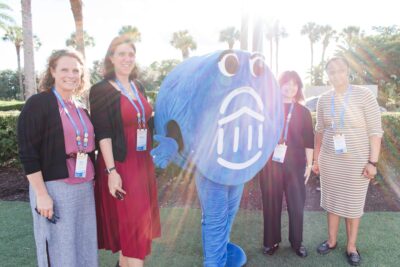What does “student success” really mean?
What does student success mean today? It’s something I’ve been thinking about as my oldest son begins his first year of college this year. To understand how we can better help students achieve success beyond the traditional measure of a diploma, I asked four of my colleagues to weigh in.
Read on to learn how the definition of student success has changed, and how we evolved our leading CRM, Navigate360, to meet today’s needs.
If you were a student today, what would “success” mean to you?
“Feeling like the investment was worth it” – Christina Hubbard, Senior Director, Research Advisory Services

If I were a college student today, I’d read the headlines and seek confidence that my time and money were going to pay off. Public confidence in higher education is plummeting and the number of prospective students telling us they aren’t sure college is worth it has more than doubled in the past four years. Yet, the wage premium for college degree holders is still strong.
So, how do we counter the negative perceptions about higher education? We have to ensure that every student we bring to our campuses has a clear pathway to on-time graduation. And that’s going to take a network of people, processes, and technology that keep students at the center of our work—something Navigate360 calls “coordinated care.”
We have so many EAB partners we can learn from when it comes to implementing coordinated care. University of Alaska Anchorage created easy-to-access degree maps in Navigate360 to help students choose the right courses and engaged faculty in reporting struggling students. They saw Alaska Native on-time graduation increase by nearly 14%. York Technical College improved career exploration and academic planning and saw graduation rates rise and job placement hit a record 97%. Buena Vista University engaged faculty in identifying students who were struggling and saw first-year retention improve by 13 percentage points. Ultimately, when we break down silos and keep students at the center of our work, we can graduate more students on time and guide them to successful careers.
“Better prospects for my future” – Aash Gupta, Associate Principal, Strategy and New Ventures

If I were in school right now, I’d be hyper-focused on finding a job and beginning my career. Today, student success leaders are increasingly focusing on helping students develop a broad set of tools to identify and achieve their career—and life—goals. Today’s students expect a return on investment from higher education and they view job placement after graduation as a key value driver of that. Yet it can feel overwhelming to explore career paths, find job opportunities, understand what a job actually entails, and perform well during the interview process.
The shift in students’ expectations to place more emphasis on career and life success is something I studied closely the past few years as I helped research Navigate360’s new Journeys feature and how to apply it to career exploration and preparation. Journeys provides students with step-by-step guidance for certain goals within the student app, from choosing a major to preparing for a job interview. They are fully customizable to match the processes at your institution and can be automated too—for example, you could set a career exploration journey to launch once a student reaches 90 credits.
In an era where students increasingly expect their college experience to prepare them for the workforce and beyond, I’m excited that our partners want to use this new feature to help students connect with career resources on campus, prepare for internships and interviews, and start building careers they’re excited about.
TO CELEBRATE NAVIGATE360, WE’RE SHARING PARTNER SUCCESS STORIES FOR 360 DAYS!
“The time and energy to pursue my interests” – Ed Venit, Managing Director, Research

If I were back in college today, I’d be really nervous about the workload and what falling behind could mean for my future plans. I’d want to be sure my institution could help me catch up and be there for me when I’m facing periods of high stress or other mental health concerns.
Current students are having more trouble in college-level courses than students of the past. Concerning test score data shows us that today’s K-12 students—tomorrow’s college students—may be even further behind in their college readiness. Readiness for college math is perhaps the biggest concern given the degree to which math is foundational to high-demand majors such as Business, STEM, and the Health Sciences. Future students could find themselves frozen out of highly desirable programs because they no longer meet the bar to qualify. Colleges leaders need to start work today to reinvent their approach to math education to prepare for a future uptick in demand for support and keep their math-dependent programs viable.
Additionally, student mental health needs have been rising for at least a decade. The pandemic made these concerns much worse, to the point that many college counseling centers are overwhelmed and overcapacity. Mental health is now the top reason why students consider stopping out of school, more so than even academic difficulty or financial stress. Colleges are often their students’ first option for mental health and wellness support, so we need to find a new way to meet rising demand.
As higher ed emerges from the pandemic, it’s been my job to really understand the long-term impacts and help EAB partners prepare for the future. I’ve been especially excited by what I’ve learned from our forward-thinking Navigate360 partner schools who are using frameworks like stepped care models to reinvent their mental health offerings to be more holistic and campus-wide. In doing so, they are not only elevating mental health care from being a student service to being an institutional strategy, they’re also adapting their existing success technology infrastructure to augment support in one of the areas where students need it most.
GET YOUR COPY: 3 QUICK WINS FOR STUDENT MENTAL HEALTH AND WELLNESS
“A positive college experience” – Tara Zirkel, Director, Community College Research

If I were a student today, I would expect tech-enabled, fast, and personalized interactions that cut to the core of what I need, while still being warm and authentic. The future of student success needs to be deeply rooted in creating positive experiences for students that contribute to their sense of belongingness while simultaneously helping to proactively guide them through their academic, administrative, career, and financial planning. I’d want to start this conversation early in my journey—before I even applied—to make sure the college was the right fit for my specific needs. We know that during the initial inquiry and application process that poor experiences, including slow follow-up or getting the “run around” from office to office, can cause students to not enroll.
To create this experience, colleges need to deeply understand their students and create a campus culture where authentic supportive interactions with prospective students are the expectation, not the exception. Navigate360 extends to recruitment management, allowing community colleges and four-year schools to build early relationships with prospective students by coordinating messaging campaigns, tracking event attendance, and collecting inquiry information all in one place. For a student, this transparency allows educators to have a clear understanding of their career goals, what types of learning modalities work for them, and which tasks they need to complete to all while boosting overall inquiry and applicant conversions. For example, through leveraging Navigate360, Cerro Coso College increased inquiries by 100% and Central Virgnia Community College grew their inquiry to applicant yield to 56%.
WANT TO KEEP DISCUSSING THE FUTURE OF SUCCESS? WATCH OUR WEBINAR
AI innovation will power tomorrow’s success
There’s one thing looming in the background of every conversation about college and the future that we haven’t addressed yet—AI. It’s hard to go a day without hearing about new innovations in generative AI and what they could mean, good and bad, for learning, work, and more. While AI can often feel like hype, the reality is that it’s already arrived on campus: recent surveys found 89% of students admitted to using ChatGPT in their coursework and 67% of higher ed staff reported using generative AI for their work in the past year. For future-thinking higher ed leaders, the next few years should be focused on how to thoughtfully integrate AI into your operations to make the greatest impact for students and the institution.
That’s why I’m so excited by the work we’ve started piloting with a group of Navigate360 partners on new AI-powered capabilities. From making it easier to build reports and create advising campaign content to developing better student resource chatbots, these new capabilities are designed to free up staff time for meaningful student interaction. Our partners are excited about this innovation, and I look forward to sharing the results with you in the coming year.
WHAT EVERY CABINET LEADER NEEDS TO KNOW ABOUT AI AND THE FUTURE OF HIGHER ED
Evolving with you
As I look back on the first decade of our work in student success, I can see that a lot has changed. Success isn’t just a diploma anymore; it’s a fulfilling college experience, an exciting new career, and more. While retaining and graduating students is still at the core of student success, our partner institutions are evolving to meet new expectations, and we’re evolving alongside them. There’s no denying that higher ed has a lot of work ahead, but I can’t think of a time I’ve been more excited about the future or more honored to support institutions that are shaping a bright future for all students.
Recruit, Retain, and Empower Students
Would you like to learn more about Navigate360 and how to simplify the way your campus supports students? Please submit the completed form to speak with an EAB expert.

More Blogs

Four signs it’s time to break up with your student CRM

Three lessons from 1,200 student success leaders on higher ed’s future
